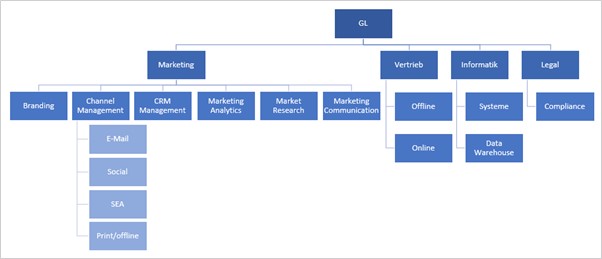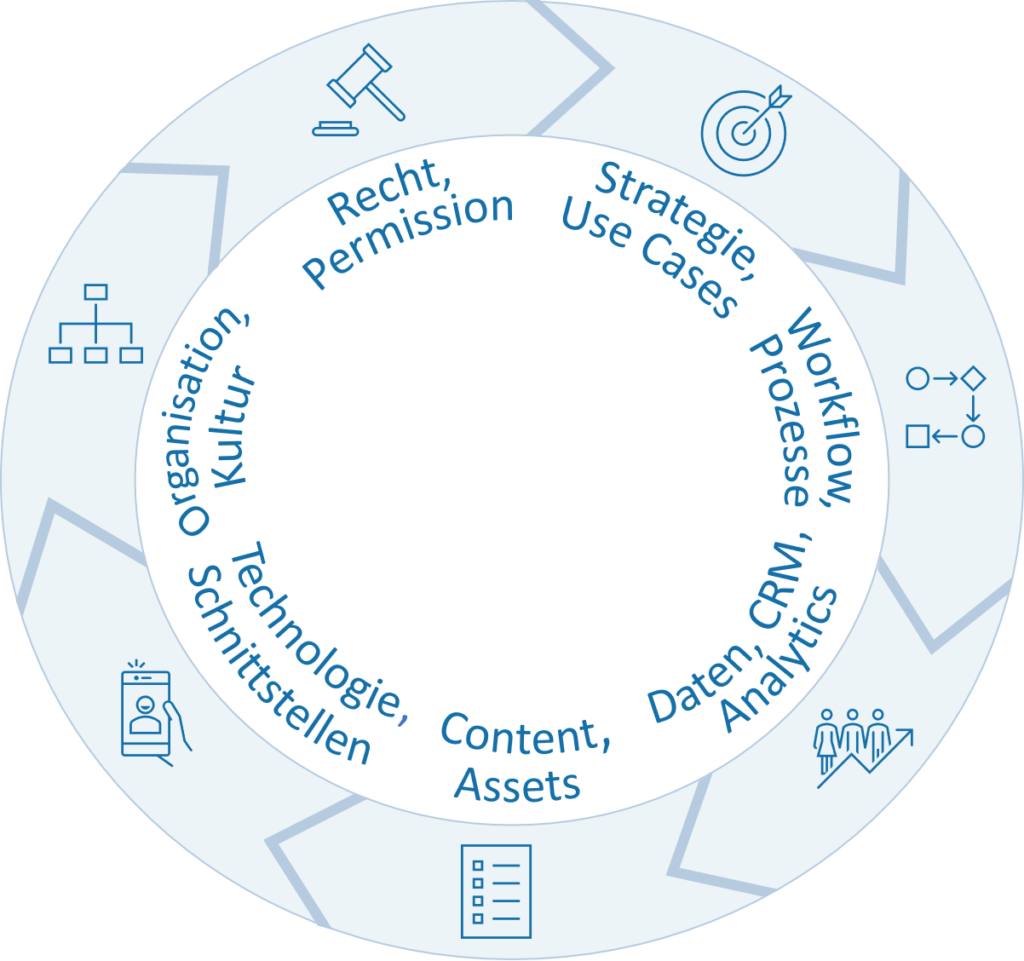Marketing AutomationMarketing Automation ist ein Framework bestehende aus Strategie (First Party Data und Marketing), Use Cases und Prozessen, Daten bzw. Customer Data Platform, Technologien, Inhalten, Organisation und Skills sowie dem Rechtsrahmen bzw. dem Consent Management.... – Technological Wonder Weapon or New Mindset for Effective, Customer-Centric Marketing and More Sales – Part 3
Organization and culture:
As already described at the beginning: Marketing AutomationMarketing Automation ist ein Framework bestehende aus Strategie (First Party Data und Marketing), Use Cases und Prozessen, Daten bzw. Customer Data Platform, Technologien, Inhalten, Organisation und Skills sowie dem Rechtsrahmen bzw. dem Consent Management.... is a mindset, a change in behavior, a change process. Often the impetus comes from marketing or sales, because it sounds tempting to convert more leads to customers with simple processes. But the road there is arduous. Before digitization, marketing was more straightforward: one goal, one campaign, one budget, one measurable outcome.
Marketing automation, consisting of several modules and tasks, requires an interdisciplinary approach and thus specialists from different departments for meaningful implementation:
- Marketing: branding, positioning, lead generation, channel marketing, marketing analytics; lifecycle management
- Sales: sales management, customer care, upselling, cross-selling, retention
- CRM and business analytics: data analysis, targeting, target group analysis and selection
- Information technology: technology stack, interfaces to peripheral systems, data security, data platforms
- Legal: Consent Management, regulatorischer Rahmen und Compliance, DatenschutzLegal: Consent management, regulatory framework and compliance, data protectionIt is not enough for companies to aggregate your users' data. They must also obtain permission to use this data at the same time. They must obtain an overview of whether and for what purpose they may actively use this personal data or use it for advertising...
The task must be driven strategically and across departments; change must start at the very top of the hierarchy. Existing power centers, the traditional silos with their own goals and budgets can be broken down and common goals identified. If you simply want to automate the topic of lead generation in inbound marketing a bit, you will find out at the latest when qualifying the leads that sales should now take over and perhaps drive a completely different strategy. Anyone who wants to perform profiling of customer data (i.e., assigning customers to a certain pattern behavior) suddenly realizes that the privacy policy does not allow for this at all and Legal was not involved. Automated lead generation with convincing ROI calculations, but also an all-encompassing dashboard of all digital marketing activities makes CEO hearts beat faster; but if the relevant departments are not involved, people do not feel picked up and skills for implementation are not available, an ambitious project quickly turns into a pipe burst.

Overarching project management is the key to success. The necessary skills must be defined, integrated or newly recruited. Resources must be made available on an interdisciplinary basis and subordinated to the strategic goal. But act very agile in manageable project teams. If you do not adapt the organization to the requirements of lean execution of marketing automationMarketing Automation ist ein Framework bestehende aus Strategie (First Party Data und Marketing), Use Cases und Prozessen, Daten bzw. Customer Data Platform, Technologien, Inhalten, Organisation und Skills sowie dem Rechtsrahmen bzw. dem Consent Management.... projects, but try to integrate them conversely into their cumbersome organization, you will find enough interests to successfully torpedo your project.
You will often run into limitations with internal specialists, especially at the beginning. A technical implementation partner is anxious to hand over the technology to you in working order. However, he often lacks the strategic (marketing) view of things. When it comes to defining and prioritizing certain use cases, you therefore want to call in external support who understands the strategy in the company, the possibilities of automation and the power of the technology.
Recommended actions:
- Think in phases during implementation. Turn a large strategic project into many small and manageable ones.
- Never lose sight of scalable goals over multiple phases and years, but start modestly and increase with the learning curve. Take the organization with you.
- Automation projects often fail because of inflated expectations, lack of resources, excessive complexity early on, and – confirming the need for sponsorship from the top – unspeakable politics and unwillingness to change.
- Start with small project teams, celebrate initial successes, and use them to gain allies for larger goals.
- Involve internal and external specialists, especially at the beginning.
Law – especially data protectionIt is not enough for companies to aggregate your users' data. They must also obtain permission to use this data at the same time. They must obtain an overview of whether and for what purpose they may actively use this personal data or use it for advertising... and opt-in:
In many areas of economic life, the regulatory landscape is an established, rather static and somewhat manageable framework for companies’ room for maneuver. This is not the case for marketing automation, where, especially in Europe, the legal situation has fundamentally changed as a result of rapid technological developments. In May 2018, the famous DSGVO (General Data ProtectionIt is not enough for companies to aggregate your users' data. They must also obtain permission to use this data at the same time. They must obtain an overview of whether and for what purpose they may actively use this personal data or use it for advertising... Regulation) was introduced as directly applicable law in the European Union. The essential data protectionIt is not enough for companies to aggregate your users' data. They must also obtain permission to use this data at the same time. They must obtain an overview of whether and for what purpose they may actively use this personal data or use it for advertising... legal framework for dialog marketing was thus harmonized throughout Europe. The focus is on personal data (i.e., structured and unstructured, user-related data; see above), which is to be processed for advertising purposes with or without consent. The legislator has enacted regulations which attempt to understand and get to grips with what is technically feasible. Since the entry into force, the indeterminate provisions have been continuously clarified in specific legal cases by judicial law.
A second framework is to be set in the next 1-2 years by the e-Privacy Directive. This deals with the use of cookies for advertising purposes. It can be assumed that these will be used much more restrictively in the future, and in some cases only with consent, so that the advertising forms of (re-)targeting, which have become very intrusive in recent years, are put back in their place. The so-called third-party cookies, i.e. the setting of code elements from third-party providers (as an example, providers from social media, tracking tools, display advertisers) on the company website for the most sophisticated possible formation of behavioral profiles for the playing out of advertising, are to be strongly pushed back or completely abolished. This is about data aggregation in the anonymized state of the user and not about data where the user is already identifiable as required by the GDPR. The highest court in Germany has already ruled that for most cookies, i.e. also first-party cookies (for direct use by the company itself), voluntary consent of the user is required.
In both cases, liability for companies is to be greatly expanded. This will improve sensitivity to data and the protection of individuals, and clearly define the hurdles for misuse and its consequences.
A third framework is competition law, which governs the opt-in process for the delivery of promotional emails. This is only marginally changed by the above-mentioned laws. Additional hurdles regarding the obligation to provide proof and information to the user make the so-called double opt-in obligatory: the user registering with his e-mail address must confirm again by clicking on a subsequent confirmation e-mail that he wants to receive advertising to his e-mail address in the future.
This means that the same user leaves different traces at different touchpoints in the journey through the half-life of the customer relationship with the company, which must be recorded and evaluated in detail so that the company can write to this person directly or advertise anonymously. This rights or consent managementKundendaten sind wertlos, wenn die Berechtigung zur Nutzung dieser Daten zu Marketingzwecken nicht konsequent zum jeweiligen Kontakt abgelegt werden und dieser rechtliche Status nicht laufend gepflegt wird. Technisch bedeutet eine Einwilligung... must not be underestimated under any circumstances, otherwise the much-cited 360° customer view will remain an interesting pair of glasses, the prospect of which the company may not use, however – for lack of consent by this very user. It is therefore advisable for computer scientists and lawyers or data protectionIt is not enough for companies to aggregate your users' data. They must also obtain permission to use this data at the same time. They must obtain an overview of whether and for what purpose they may actively use this personal data or use it for advertising... experts to work very closely together to map and maintain the so-called “permissions” cleanly on a data platform. On the one hand, this involves the technical handling of these rights, but also the description of the use of personal data, profiling for advertising purposes and data processing in a data privacy statement, which in turn must be explicitly accepted (largely in the EU) or only brought to the attention of the user (DSG in Switzerland). It is and remains intransparent and confusing.
Corporate management wavers between technical costs for consent management, the introduction of a comprehensive trust center (data maintenance by the user himself), the gray area of not cleanly recorded “permissions” in different systems, the threatened fines and possible reputational damage, which at best weighs even more heavily than a minor violation of the law.
It would make sense for certain countries (alliances) to create a legal area for handling data that is as geographically large and uniform as possible. This creates legal certainty and is the basis for business models with data. Any deviation with small-state data protection, as Switzerland is doing with its own new Data ProtectionIt is not enough for companies to aggregate your users' data. They must also obtain permission to use this data at the same time. They must obtain an overview of whether and for what purpose they may actively use this personal data or use it for advertising... Act (DPA) (expected to come into force in 2022), has exactly the opposite effect. Data protectionIt is not enough for companies to aggregate your users' data. They must also obtain permission to use this data at the same time. They must obtain an overview of whether and for what purpose they may actively use this personal data or use it for advertising... in today’s digital internationally networked world can only be enforced and sanctioned multilaterally, because the essential corporate targets are per se on the move internationally. The local data protectionIt is not enough for companies to aggregate your users' data. They must also obtain permission to use this data at the same time. They must obtain an overview of whether and for what purpose they may actively use this personal data or use it for advertising... officer in Canton XY of Switzerland stands there like Sisyphus on a mountain and is an anachronism of a federalist monument that is completely outdated in this area.
For the company, the requirements for compliance and thus for a dedicated data protectionIt is not enough for companies to aggregate your users' data. They must also obtain permission to use this data at the same time. They must obtain an overview of whether and for what purpose they may actively use this personal data or use it for advertising... officer are becoming greater. His appointment is mandatory in the EU since 2018, in Switzerland it is only recommended by the legislator. Cookie banners for collective wiping away are no longer permitted in the EU, but in Switzerland they are. The privacy statement is newly mandatory in Switzerland, but it does not have to be explicitly accepted by the user for the use of personal data or for automated profiling, as is the case in the EU. So what does a company that serves international markets do? It strictly adheres to the GDPR and largely ignores the DPA. A look at the sanctions confirms this, because the DPA deals with fines in the amount of 10 million euros or up to 2% of the global annual turnover. Switzerland does not know a corporate fine, but only personal sanctions or fines up to CHF 250,000. For the CEO, the risk assessment is more difficult. The orientation towards the law and its sanctions is one thing, a possible damage to reputation weighs even more in many cases.
Recommendations for action:
- Understand exactly what the GDPR and the new DSG mean for you: personal data, profiling, data processing, disclosure obligations, sanctions.
- Appoint a data protectionIt is not enough for companies to aggregate your users' data. They must also obtain permission to use this data at the same time. They must obtain an overview of whether and for what purpose they may actively use this personal data or use it for advertising... officer to anchor the topic in the company. Involve him or her at an early stage when it comes to customer data and rights.
- Revise their privacy policy so that they are allowed to use personal data optimally for marketing purposes.
- Consider how you may use first and third party cookies in the future and how they collect permission to do so.
- Implement a clean double opt-in process for email marketing.
- Document the entire permission handling on a data platform; possibly provide the customer with a self-service “trust center” where he can manage his data himself.
The checklist:
And finally, a summary and small checklist of what you’ll want to use to get started on your automation adventure:
- Define goals: More new customers, more better customers, more engagement, save costs.
- Think strategically, long-term and interdisciplinary, not campaign-oriented. Nothing works without commitment from the top.
- Define simple use cases (“quick wins”), build the learning curve, become more complex and data-driven.
- Think through and create processes based on the use cases; measure and optimize processes; define KPI.
- Deliver content efficiently according to content strategy; content comes from product positioning and own topic authority in the company.
- Data, data, simple data; use structured and over time unstructured data; build data base; analysis and target group selections.
- Evaluate tools and consider interfaces to surrounding systems; automation does not start with technology, but with mindset.
- Obtain permission, i.e., rights to use e-mail address and personal data.
- Define roles and combine resources across disciplines; the marketing specialist becomes the marketing engineer.
- Don’t neglect change process. Platform technologies with centralized dashboards are every CEO’s dream. But if you don’t bring your employees along with you, you will “fail”.


